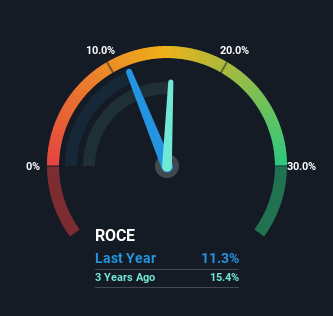- Greece
- /
- Oil and Gas
- /
- ATSE:ELIN
Elinoil Hellenic Petroleum's (ATH:ELIN) Returns On Capital Not Reflecting Well On The Business

If you're not sure where to start when looking for the next multi-bagger, there are a few key trends you should keep an eye out for. In a perfect world, we'd like to see a company investing more capital into its business and ideally the returns earned from that capital are also increasing. If you see this, it typically means it's a company with a great business model and plenty of profitable reinvestment opportunities. In light of that, when we looked at Elinoil Hellenic Petroleum (ATH:ELIN) and its ROCE trend, we weren't exactly thrilled.
What Is Return On Capital Employed (ROCE)?
For those who don't know, ROCE is a measure of a company's yearly pre-tax profit (its return), relative to the capital employed in the business. Analysts use this formula to calculate it for Elinoil Hellenic Petroleum:
Return on Capital Employed = Earnings Before Interest and Tax (EBIT) ÷ (Total Assets - Current Liabilities)
0.11 = €12m ÷ (€289m - €186m) (Based on the trailing twelve months to June 2022).
Therefore, Elinoil Hellenic Petroleum has an ROCE of 11%. In isolation, that's a pretty standard return but against the Oil and Gas industry average of 15%, it's not as good.
Check out our latest analysis for Elinoil Hellenic Petroleum

While the past is not representative of the future, it can be helpful to know how a company has performed historically, which is why we have this chart above. If you want to delve into the historical earnings, revenue and cash flow of Elinoil Hellenic Petroleum, check out these free graphs here.
What The Trend Of ROCE Can Tell Us
In terms of Elinoil Hellenic Petroleum's historical ROCE movements, the trend isn't fantastic. To be more specific, ROCE has fallen from 18% over the last five years. Although, given both revenue and the amount of assets employed in the business have increased, it could suggest the company is investing in growth, and the extra capital has led to a short-term reduction in ROCE. And if the increased capital generates additional returns, the business, and thus shareholders, will benefit in the long run.
Another thing to note, Elinoil Hellenic Petroleum has a high ratio of current liabilities to total assets of 65%. This effectively means that suppliers (or short-term creditors) are funding a large portion of the business, so just be aware that this can introduce some elements of risk. While it's not necessarily a bad thing, it can be beneficial if this ratio is lower.
Our Take On Elinoil Hellenic Petroleum's ROCE
While returns have fallen for Elinoil Hellenic Petroleum in recent times, we're encouraged to see that sales are growing and that the business is reinvesting in its operations. These trends are starting to be recognized by investors since the stock has delivered a 31% gain to shareholders who've held over the last five years. So this stock may still be an appealing investment opportunity, if other fundamentals prove to be sound.
Like most companies, Elinoil Hellenic Petroleum does come with some risks, and we've found 3 warning signs that you should be aware of.
While Elinoil Hellenic Petroleum isn't earning the highest return, check out this free list of companies that are earning high returns on equity with solid balance sheets.
Valuation is complex, but we're here to simplify it.
Discover if Elinoil Hellenic Petroleum might be undervalued or overvalued with our detailed analysis, featuring fair value estimates, potential risks, dividends, insider trades, and its financial condition.
Access Free AnalysisHave feedback on this article? Concerned about the content? Get in touch with us directly. Alternatively, email editorial-team (at) simplywallst.com.
This article by Simply Wall St is general in nature. We provide commentary based on historical data and analyst forecasts only using an unbiased methodology and our articles are not intended to be financial advice. It does not constitute a recommendation to buy or sell any stock, and does not take account of your objectives, or your financial situation. We aim to bring you long-term focused analysis driven by fundamental data. Note that our analysis may not factor in the latest price-sensitive company announcements or qualitative material. Simply Wall St has no position in any stocks mentioned.
About ATSE:ELIN
Elinoil Hellenic Petroleum
Engages in the supply of liquid and solid fuels, and lubricants for industrial plants worldwide.
Moderate with mediocre balance sheet.
Market Insights
Community Narratives



